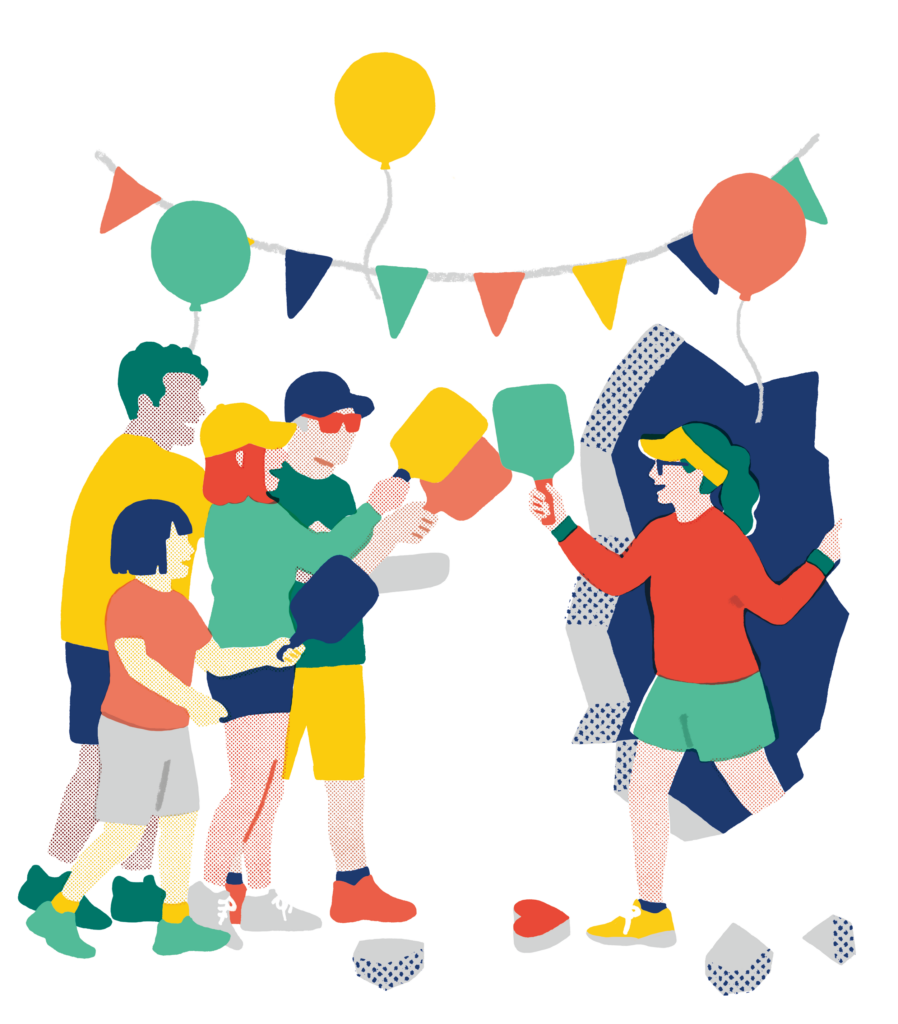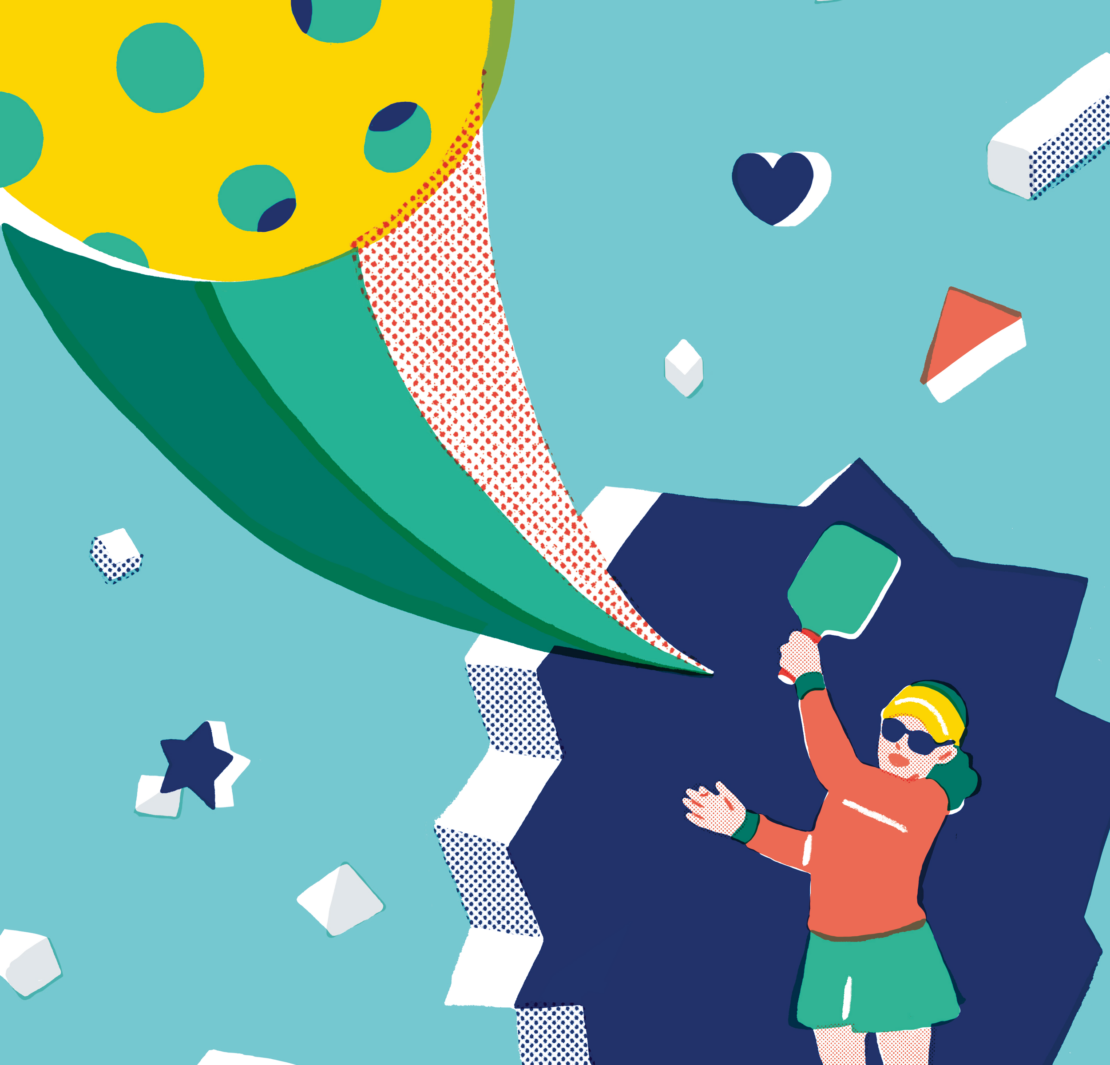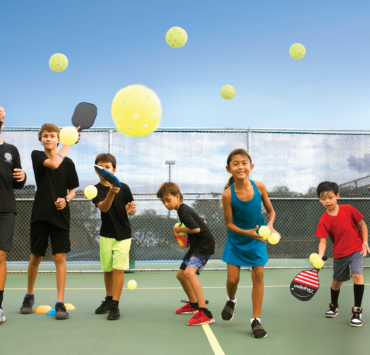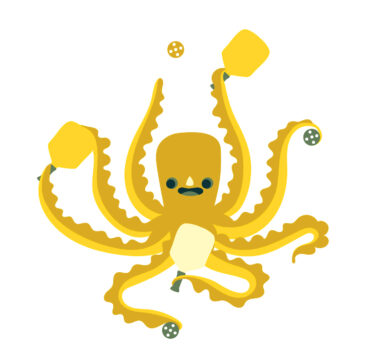I BLAME THE WIND. It’s picked up since we arrived at the beachside pickleball courts. Clouds scud across the sky, blocking the sun, and lines of sand shiver along the fence line. It’s only my second time out playing pickleball and I’m starting to think it might be my last. A solid tennis player, I’d been confident that my skills on a tennis court would easily translate to pickleball. I’d been wrong. But it’s the wind, right? Taking the ball places I never meant it to go?
I glance over at my husband, Jack. He smiles encouragingly. Across the net is my brother-in-law Bobby, a middle school gym teacher and a champ at cheering even the most athletically challenged to victory. “You got this!” he booms. His partner, my friend Wendy, looks a lot less certain. Her paddleball skills have served her a lot better than my tennis ones have and she’s killing it on the court, wind or no wind, while I have yet to land a successful dink or manage a volley or block anything coming right at me.
But then something happens. The sun comes out, warming our backs. The wind dies down just a bit. I push up my sleeves and adjust my visor. It’s my turn to serve. I manage to announce the score correctly: 3-9-2. I toss up the ball and whack it over the net. Bounce back, bounce back, and then I lunge to the right, dipping to swipe the ball just as it comes up. A perfect arc, up and over, and the ball drops short on the cross court and then swerves off, an unreachable winning dink of a dink.
PICKLEBALL IS ABOUT MORE THAN FUN. IT’S ABOUT COMMUNITY.
The elation is immediate. For that split second, I’m experiencing something akin to joy, an emotion I haven’t felt much of over the past year and a half. And best of all, my elation is shared. The other three players all whoop in admiration (or in complete and utter surprise) and we share the joy, celebrating together my moment of triumph. No fear, no hesitation, no question. I go back to the line and serve again. I am hooked for good on pickleball.
I came late to the sport of pickleball. Or should I say I came late to the party? Because pickleball is a party, the best kind of party. The whole community is invited, the dress code is whatever is comfortable, and there’s no need to bring anything fancy—the simplest of paddles will do. Pickleball is the kind of party I used to love going to before the pandemic hit.

A FRIEND SUGGESTED I try pickleball after hearing me complain too many times about the pounding that tennis was inflicting on my aging body. Not as much running as in tennis, she told me, so easier on my knee. Courts available year-round. I could pick up a paddle and balls for less than what I was paying for an hour of tennis. Why not, I thought. Can’t be too hard. But what drew me most of all was the word that came up anytime I talked about pickleball with anyone—and everyone I knew was talking about pickleball—and that word was fun.
My friend Sally, who had just moved to Wyoming with her family when Covid-19 hit, told me pickleball was a game that her whole family played when they were stuck together for weeks on end: “We had so much fun, and you know how competitive my family is!” Together they all got better at it, and now that quarantining is over, they still play, and not only with each other. They play with new neighbors, visiting cousins, aging uncles and aunts. It’s multigenerational and cross-community.
TURNS OUT PICKLEBALL IS WHAT PEOPLE NEED RIGHT NOW.
“Now Charlotte goes out there and plays with her friends,” Sally tells me about her daughter. A group of twenty-somethings playing pickleball, and why? Because it’s fun.
But pickleball is about more than fun. It’s about community. Like Sally’s new community in Wyoming, the people she’s met playing pickleball have become friends. My friend Pam painted the lines of a pickleball court on her driveway during the pandemic and sent out a message to all her neighbors: Come play! And they did. Her court is the hot spot now for get-togethers. After months of being isolated in their homes, Pam and her neighbors are reconnecting. They’re finding fun in being part of a community when, for far too long, we only found anxiety, suspicion, and fear.
A neighbor painted a court on her driveway for the kids to play on, but now she is as passionate about the sport as they are. And she’s not alone: Everyone I know who plays says they not only want to play, they need to play. Pickleball is bringing them back to life after too many months of isolation and inactivity.

For me, pickleball has also been about change: challenging myself to learn new rules, to use my body in a different way from playing tennis or walking, my usual go-to activities. Pickleball is harder than I thought it would be. I mean, the scoring? The way the ball moves (unpredictably). The fast pace. But pickleball is not too hard. The past months of quarantining and sanitizing were too hard; pickleball is just right. Pickleball challenges but also gives: It gives me joy, gives me community, gives me fun. It gives me just what I need now.
Turns out pickleball is what a lot of people need right now. Aspen Kern, a pickleball player and coach, started a group on Facebook in 2017. Called Pickleball Forum, it now has more than 55,000 followers, with a huge surge coming in the past year and a half. As Aspen explained it in a post this past summer, the sport and the group gave him “the opportunity to ‘come out of my shell’ and see the beautiful world of friendships. So many of you have written me…that the sport has changed their lives for the better.”
I’m back on the court with Jack, Wendy, and Bobby. We mix up the teams, Wendy and me against Jack and Bobby. On the next court over, a couple of 10-year-old boys are playing with their mothers and having a great time. But I can tell the kids really want to play against Jack and Bobby. So we make the switch. Wendy and I take on the moms, and Jack and Bobby take on the 10-year-olds. We lose, the men lose, but everyone is happy. And no one is happier than the kids.
“See you next time!” they call out as their mothers herd them into the car. And they will. Next time and all the times after.
Nina Sankovitch is the author of four nonfiction books, including the award-winning American Rebels: How the Hancock, Adams, and Quincy Families Fanned the Flames of Revolution and the memoir Tolstoy and the Purple Chair.



